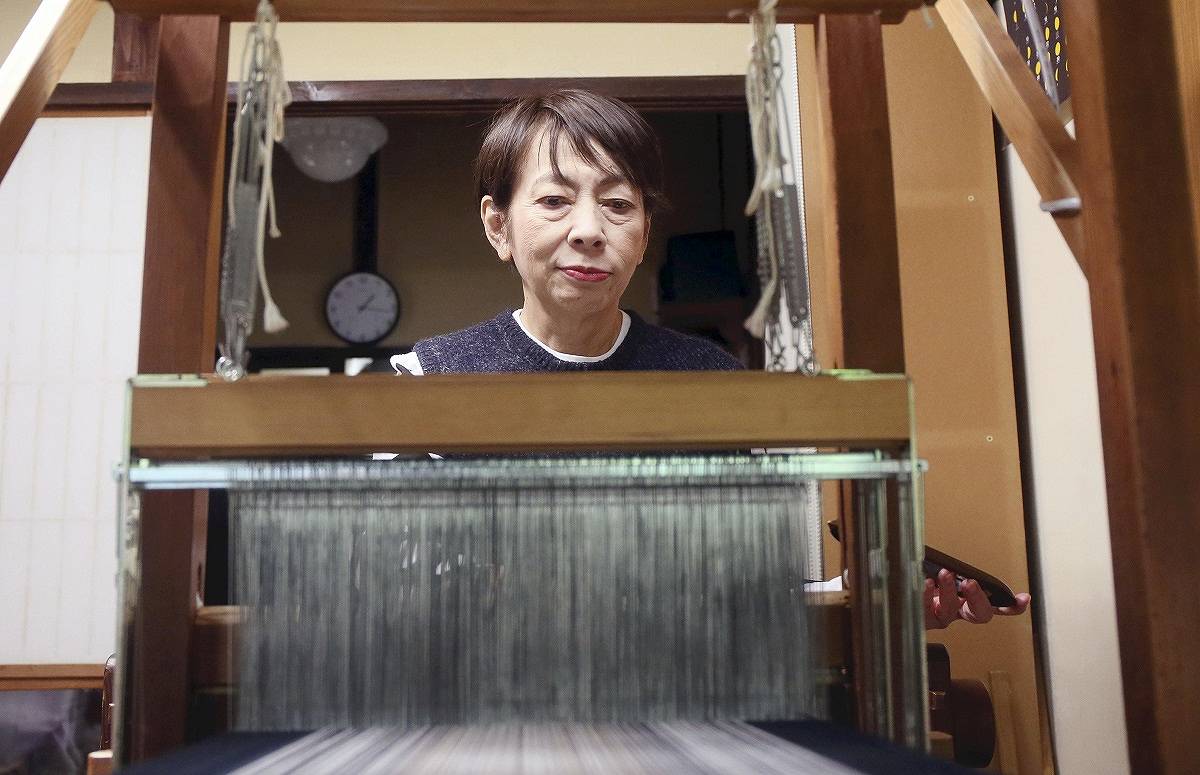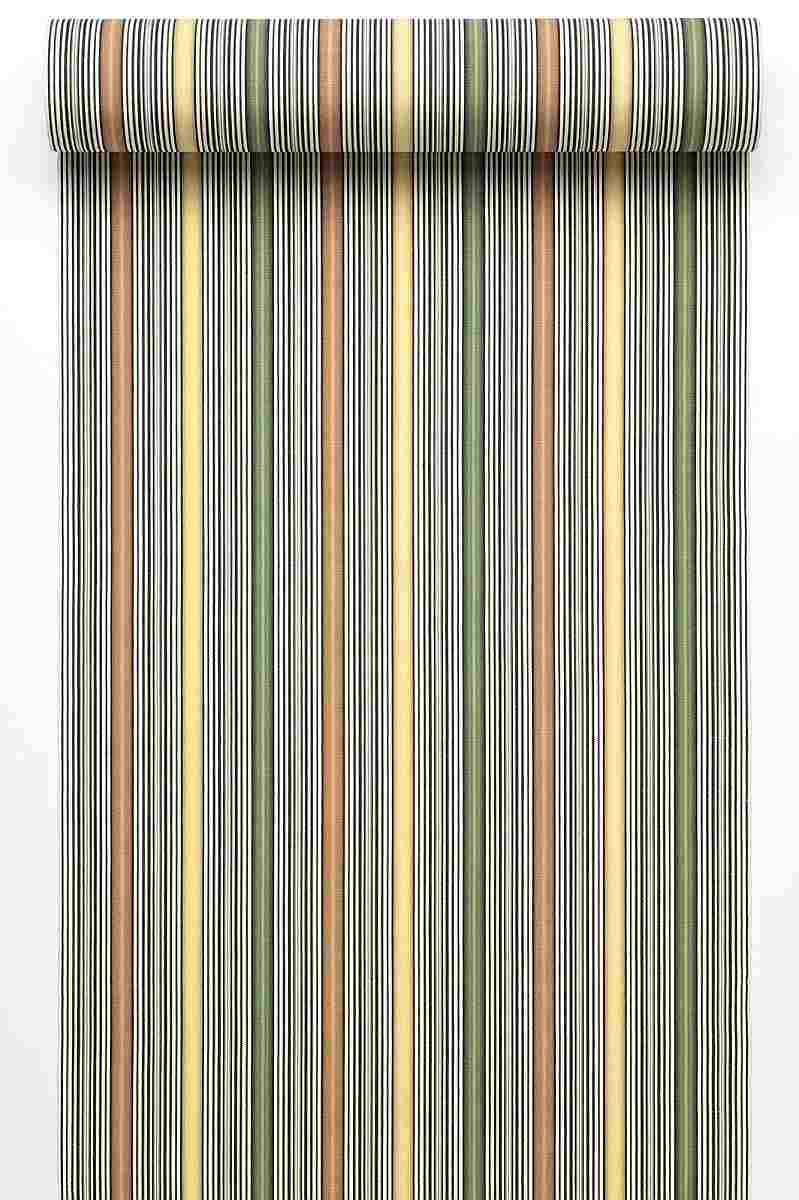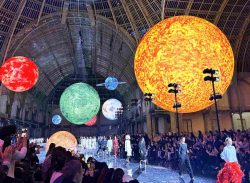
Noriko Tsuiki talks about the attractiveness of Kokura-ori textiles at her atelier in November in Kitakyushu.
15:00 JST, March 10, 2024
FUKUOKA — Kokura-ori is a cotton fabric that was once used to make samurai hakama pants and other products, but fell out of fashion in the early Showa era (1926-1989). Kitakyushu-based fabric-dyeing artist Noriko Tsuiki, 71, revived the textile 40 years ago and has been pursuing the beauty of its vertical-striped patterns created using many different colored threads. Her designs are well-suited for a wide range of products beyond textiles, helping Kokura-ori grow into a material culture that represents Kitakyushu.
At an atelier in a mountainous part of Yahata-Higashi Ward, Kitakyushu, looms thump in time with classical music.
Kokura-ori textiles are produced by repeatedly weaving warps through wefts. To weave a single traditional obi sash, the operation of inserting wefts into a weaving machine must be repeated more than 30,000 times. “Since Kokura-ori uses high-density warps, inserting the wefts requires some strength,” Tsuiki said. The level of concentration required for effectively weaving evenly can last for up to an hour. To help with timing, the atelier has more than 100 CDs, including operas and folk music. When one CD ends, she takes a short break to make mental and physical preparations and then continues to weave.

Tsuiki weaves Kokura-ori in November at her atelier in Kitakyushu.
The production of Kokura-ori textiles started in the Buzen Kokura domain in the Edo period (1603-1867). The textile was so strong that it was said to be impervious to spears. Kokura-ori fabric was widely available and was used for samurai hakama pants and obi sashes. Tokugawa Ieyasu, the founder of the Edo shogunate, is said to have worn a Kokura-ori haori coat when he engaged in falconry. In the Meiji era (1868-1912), the textile was used to make school uniforms. However, fake or low-quality products were produced in many parts of the country and a wave of mechanization hit Japan. Under these conditions, the production of Kokura-ori stopped in the early Showa era.
Tsuiki encountered the long-gone and mostly forgotten textile at the age of 30, when she was pursuing a career in dyeing and weaving. She found a 10-centimeter strip of fabric at an antique shop she frequented in Kitakyushu. The fabric was shiny, like tanned leather, and had a smooth texture. Picking up the old cloth, with its stylish vertical-striped patterns, she was moved and thought, “This is what I’ve been looking for.”
The unique patterns are created by using more warps than wefts. She read the few documents related to the textile she could find at libraries and museums. She also analyzed how it was woven and the thickness of threads in cooperation with a research institute. However, she was not able to recreate the right texture, even though she wove in the same way. After nearly two years of trial and error, she finally recreated Kokura-ori textiles in 1984 by spreading 2,160 warps, nearly three times the number of wefts, over a width of about 35 centimeters, and established a technique for weaving at a density where the loom barely moved.

Tsuiki’s Kokura-ori fabric
Tsuiki was born in the city of Yahata, present-day Yahata-Higashi Ward, Kitakyushu, in 1952. She learned dyeing and weaving techniques in Kume Island in Okinawa Prefecture among other places. She supervises the design process of “Kokura Shima Shima,” a shop that produces machine-woven products. In 2008, she was awarded the Cultural Affairs Agency commissioner award at the Japan traditional craftwork dyeing and weaving exhibition.
“I want many people to use the fabric as a general-purpose product,” she said. With that goal in mind, she has made efforts to develop machine-woven fabrics. She has tried to introduce Kokura-ori fabrics in clothing, fashion accessories and interior decorations while also producing art pieces. “I want to create vertical-striped patterns that no one has never seen before,” she said. She has continued her dogged pursuit even after turning 70.
"Culture" POPULAR ARTICLE
-

Van Cleef & Arpels Dazzles with Art Deco Artisanry at Tokyo Exhibit
-

Disney’s ‘Twisted-Wonderland’ Animated Series Puts Villains in Spotlight: New Show Features School Inspired by Classic Disney Films
-

Ayumi Hamasaki’s Shanghai Concert Canceled Day Before Schedule as Part of Beijing Backlash
-

‘The World Masterpiece Theater Series’ Celebrates 50 Years; Animator Looks Back on Creating Anime Classics
-

Popularity of Piggy Banks Across Time and Place Seen at Bank’s Museum of Money Boxes in Hyogo Pref.
JN ACCESS RANKING
-

Tokyo Economic Security Forum to Hold Inaugural Meeting Amid Tense Global Environment
-

Keidanren Chairman Yoshinobu Tsutsui Visits Kashiwazaki-Kariwa Nuclear Power Plant; Inspects New Emergency Safety System
-

Imports of Rare Earths from China Facing Delays, May Be Caused by Deterioration of Japan-China Relations
-

University of Tokyo Professor Discusses Japanese Economic Security in Interview Ahead of Forum
-

Japan Pulls out of Vietnam Nuclear Project, Complicating Hanoi’s Power Plans


























